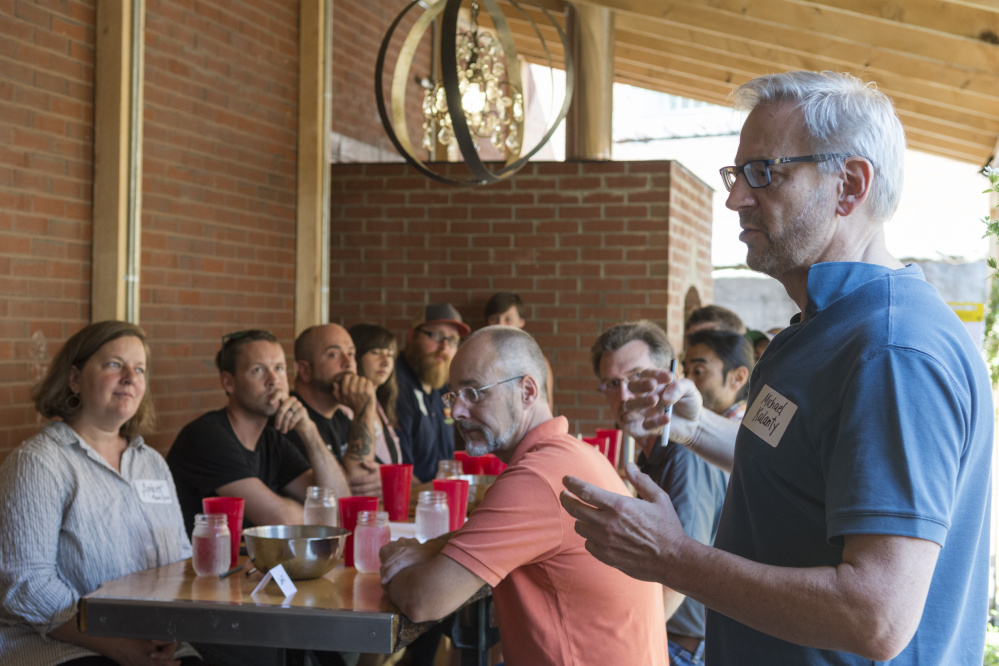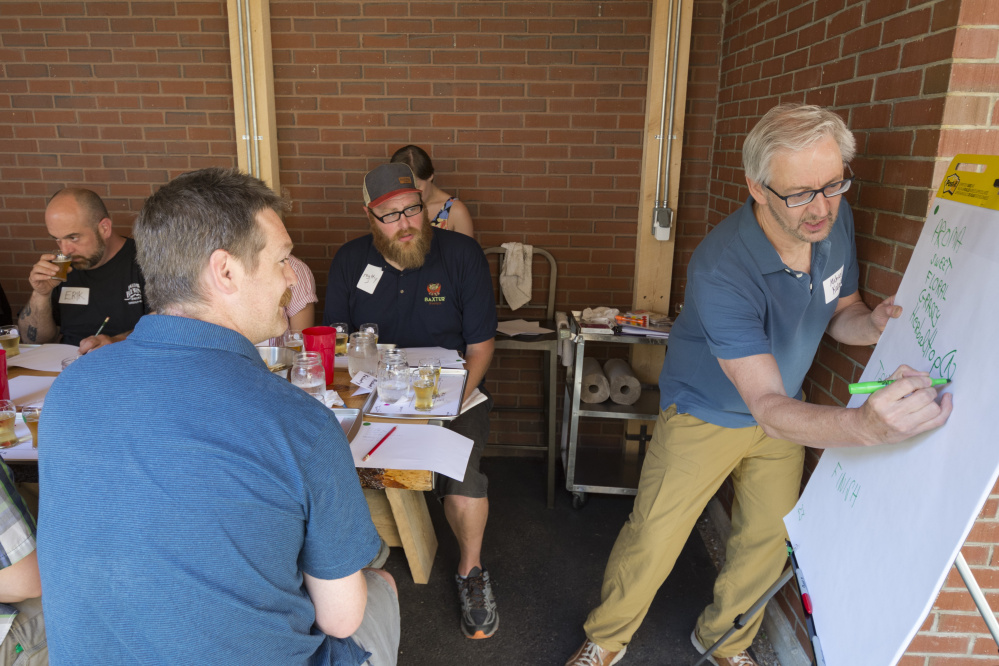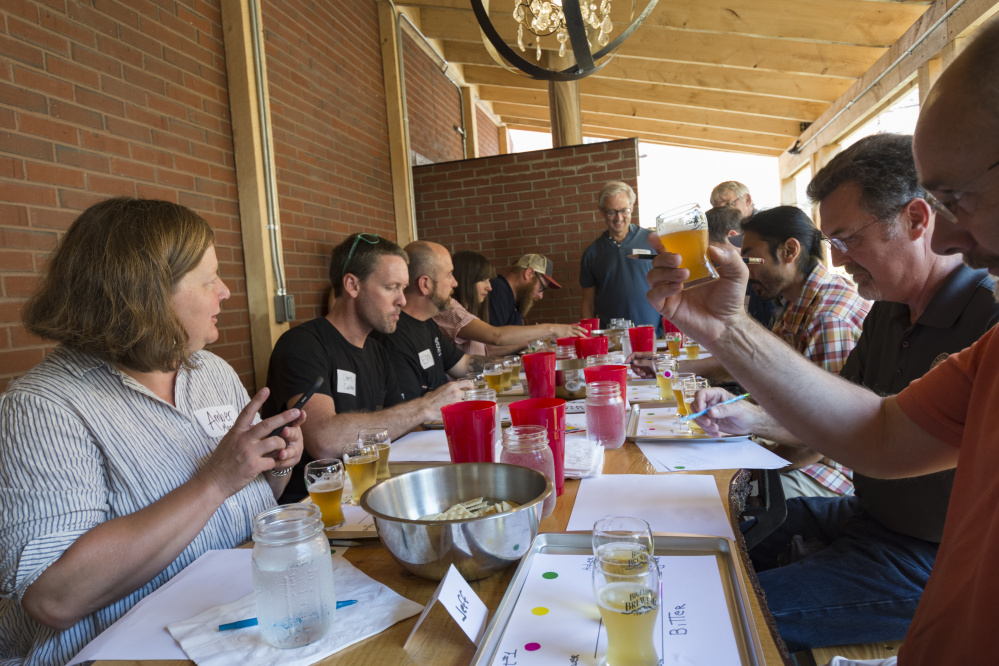SKOWHEGAN — “Oh dear, bread and beer; … if I were rich, I wouldn’t be here” may be part of an old Irish drinking song, but on Wednesday it was serious business.
The science of the crust and crumb came face to face at the Miller’s Table Cafe at the Somerset Grist Mill with the aroma, texture and finish of the hops and the malt — bread and beer — all made from Maine grains.
Drawing on decades of success pairing wines with certain foods, the idea behind Wednesday’s “Beer-Bread Pairing and Ideation Session” was to have expert brewers, bakers and chefs sample bread and craft beer options to see how they go together, said Darryll White, of Sidney, a consultant for Amber Lambke’s Maine Grains. He said he and Lambke attended the New England Craft Beer Summit in Portland in March and came home with lots of ideas.
“One of the presentations talked about the explosive growth in the craft brew industry in Maine, but they also expressed some concern looking forward about potential market saturation — more breweries opening than can be supported by the demographics,” White said.
One potential strategy was the concept of pairing craft beer and food, he said.
Enter Michael Kalanty, of San Francisco, a renowned sensory scientist, baker and author who facilitated Wednesday’s daylong ideation sessions, tasting six beer samples and three bread samples, taking notes and presenting observations — blind, with no labels — at the end.
Brainstorming later in the day posed simple questions: What pairing patterns did the panel find in the six beers and three bread types presented, and which samples had the most potential?
Sessions began Wednesday with group palate calibrations of samples provided by the six invited brewers and six invited bakers. The six beer styles included a pilsner, a pale ale, an India pale ale, a Belgian style golden strong ale, a German wheat lager, and a stout. Breads included pretzels, crackers and multi-seed bread.
Each of the panel participants was given a bell jar of water and a red “spit cup” to cleanse the pallet after each taste to “keep a fresh mind about you,” Kalanty said. “Your pallet is reset to zero.”
Each panel member also was given sheets of paper and a secret two-digit code to take notes anonymously on score cards, which will be examined for a final report by Kalanty. All of the beers were identified only by a colored dot, again for anonymity.
“The whole idea is that people have preferences. If you see anything with a label on it or anything like that, throw a flag on the play,” Kalanty told the group.
Panel members were looking for aroma, body, texture and flavor of each beer and how they coupled with the bread offerings. Participants smelled the beer, held it up to the light, sipped and swished the liquid around in their mouths one beer at a time, with lots of discussion. Words such as “sweet,” “floral,” “herbal” — even “noble” emerged.
Matty Johannes, of Baxter Brewing Co., liked the “hop taste” of one of the samples. Branch Rothchild, of Allagash Brewing, spoke of the texture, the bubbles and the finish.
“We wanted to do it in a way that was credible and as scientific as possible, but obviously there’s a lot of psychology with trying to manage sensory input,” White said. “Among our general goals is (to see if we) can categorize certain foods or certain flavors or certain textures that could be produced in a bread format to be paired with certain styles of beer.”
White said tasting rooms at some Maine breweries don’t have kitchens, so bringing prepared or packaged bread products from off the site could unite the tastes for an overall new experience.
“If we create what is perceived as value by the food or the beer industry, that’s a stepping stone,” White said. “This is exploratory, but we’re trying to do it scientifically. It’s a systematic, methodical approach.”
White said all the information collected Wednesday will be gathered for a final report by the end of the week.
On the baking side of Maine Grains at Wednesday’s program, Kerry Hanney, of Night Moves, a small baking business in Portland, said her bakery uses all local grains so they fit right in with all the brewers.
“It’s great to be a part of this. We’re all using a lot of the same grains, so it’s interesting to see the flavor coming together from two different types of fermentation,” Hanney said.
Lambke, who purchased the stone-and-steel 1897 former Somerset County Jail in 2009 and turned it into a grist mill and the seat of Maine Grains, told the gathering she and others met Kalanty at the 2016 Kneading Conference.
“He did a presentation on the sensory analysis of bread,” Lambke said. “He is one of the first bakers to try to put a vernacular together on how to discuss crumb and crust and the full depth of flavors that you can experience in bread. Our goal here on behalf of Maine Grains is we’ve got an emerging movement around trying to use more local grains in both bread and beer.”
Doug Harlow — 612-2367
Twitter:@Doug_Harlow
Send questions/comments to the editors.








